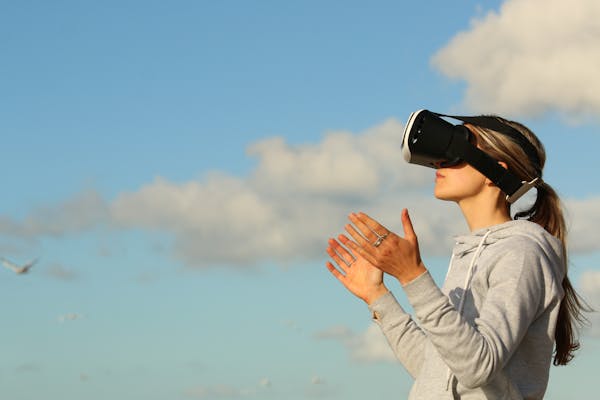
Virtual reality (VR) has emerged as one of the most exciting and transformative technologies of the 21st century. By immersing users in a computer-generated environment, VR offers experiences that are both engaging and impactful across various sectors, from entertainment and education to healthcare and business. This article explores the numerous benefits of virtual reality, highlighting how it enhances our lives and transforms industries.
Top Benefits of Virtual Reality
1. Immersive Learning and Education
Enhanced Engagement and Retention
One of the most significant benefits of virtual reality in education is its ability to create immersive learning environments. Traditional learning methods often struggle to maintain student engagement, but VR can captivate students’ attention by placing them directly into the subject matter. Whether it’s exploring the solar system, walking through historical landmarks, or conducting virtual science experiments, VR makes learning interactive and engaging.
Studies have shown that VR can improve knowledge retention. When students are actively involved in an experience, they are more likely to remember the information. This hands-on approach to learning can be particularly beneficial for complex subjects, allowing students to visualize and interact with concepts in three dimensions.
Personalized Learning Experiences
VR can also provide personalized learning experiences tailored to individual needs. Adaptive VR software can adjust the difficulty level and content based on the learner’s progress, ensuring that each student receives a customized education. This can be especially beneficial for students with learning disabilities or those who require additional support.
Remote Learning Opportunities
The benefits of virtual reality extend beyond the traditional classroom. VR enables remote learning, allowing students to attend classes and participate in activities from anywhere in the world. This is particularly advantageous for students in remote or underserved areas who may not have access to quality education. VR can bridge the gap, providing equal learning opportunities regardless of location.
2. Revolutionizing Healthcare
Medical Training and Simulation
In the healthcare sector, VR has revolutionized medical training and simulation. Medical students and professionals can practice procedures and surgeries in a risk-free virtual environment. This not only enhances their skills but also reduces the likelihood of errors in real-life situations. VR simulations can replicate a wide range of medical scenarios, from routine procedures to rare and complex cases, providing invaluable hands-on experience.
Pain Management and Therapy
VR is also being used as a tool for pain management and therapy. Patients undergoing painful medical procedures or suffering from chronic pain can use VR to distract themselves and reduce their perception of pain. Studies have shown that VR can be more effective than traditional methods of pain relief, such as medication or physical therapy. Additionally, VR therapy is being used to treat mental health conditions, including anxiety, PTSD, and phobias, by exposing patients to controlled virtual environments.
Enhanced Patient Education
For patients, understanding their medical conditions and treatment options can be challenging. VR can help bridge this gap by providing visual and interactive explanations. Patients can explore 3D models of their anatomy, see how diseases affect their bodies, and understand the procedures they will undergo. This enhanced patient education can lead to better health outcomes, as informed patients are more likely to comply with treatment plans.
3. Transforming Entertainment and Media
Immersive Gaming Experiences
The entertainment industry has been one of the earliest adopters of virtual reality, particularly in gaming. VR gaming offers an unparalleled level of immersion, transporting players into virtual worlds where they can interact with the environment and characters in ways that traditional gaming cannot match. The sense of presence and realism in VR games provides a more engaging and thrilling experience.
Virtual Cinematic Experiences
Beyond gaming, VR is also transforming the way we experience movies and videos. Virtual reality cinemas allow viewers to watch films in a 360-degree environment, providing a more immersive and interactive viewing experience. This new form of storytelling can evoke stronger emotional responses and create a deeper connection with the content.
Social Interaction and Virtual Communities
Another significant benefit of virtual reality in entertainment is the potential for social interaction. VR social platforms and virtual worlds enable users to connect with friends and meet new people from around the globe. These virtual communities provide a sense of presence and shared experience that goes beyond traditional online interactions. Events such as virtual concerts, conferences, and meetups are becoming increasingly popular, offering new ways to socialize and engage with others.
4. Enhancing Professional Training and Development
Skill Development and Simulation
In professional training, VR offers a safe and controlled environment for employees to develop and practice their skills. Industries such as aviation, manufacturing, and emergency services use VR simulations to train personnel in complex, high-risk tasks. Employees can gain confidence and competence by practicing in a virtual setting without the risk of real-world consequences.
Remote Collaboration and Meetings
The benefits of virtual reality also extend to workplace collaboration. VR can facilitate remote meetings and collaboration, allowing teams to work together as if they were in the same physical space. Virtual meeting rooms and collaborative workspaces provide a more engaging and interactive alternative to traditional video conferencing. This can improve communication, foster teamwork, and enhance productivity.
Recruitment and Onboarding
For recruitment and onboarding, VR offers innovative solutions. Virtual reality job simulations can give candidates a realistic preview of the job, helping employers assess their skills and fit for the role. New hires can undergo virtual onboarding programs, familiarizing themselves with the company culture, policies, and procedures interactively and engagingly.
5. Advancing Real Estate and Architecture
Virtual Property Tours
In the real estate industry, VR has revolutionized the way properties are marketed and sold. Virtual property tours allow potential buyers to explore homes and commercial spaces without physically visiting them. This is particularly beneficial for international buyers or those looking to relocate. VR tours can showcase properties in detail, including interior design, layout, and surroundings, providing a comprehensive view that static images and videos cannot match.
Architectural Visualization
For architects and designers, VR offers powerful tools for visualization and planning. Clients can experience architectural designs in a virtual environment, walking through buildings and spaces before they are constructed. This allows for better understanding and feedback, reducing the risk of design errors and costly changes during construction. VR can also be used for urban planning, allowing stakeholders to visualize and interact with proposed developments.
Enhanced Client Presentations
Virtual reality can enhance client presentations by providing immersive and interactive experiences. Architects and real estate agents can present their designs and properties in a way that engages clients and helps them visualize the final product. This can lead to more informed decision-making and higher client satisfaction.
6. Boosting Tourism and Travel
Virtual Travel Experiences
VR can potentially transform the tourism industry by offering virtual travel experiences. Travelers can explore destinations, landmarks, and attractions from the comfort of their homes. This can be particularly appealing for those who are unable to travel due to physical limitations, financial constraints, or other reasons. Virtual travel can provide a taste of the destination, helping travelers plan their trips and decide on the places they want to visit.
Destination Marketing
For tourism marketing, VR offers a powerful tool to attract visitors. Tourism boards and travel companies can create immersive VR experiences that showcase the beauty and attractions of their destinations. Potential tourists can experience virtual tours, cultural events, and activities, inspiring them to visit in person. This can enhance the effectiveness of marketing campaigns and increase tourism revenue.
Cultural Preservation
VR can also play a role in preserving cultural heritage and history. By creating virtual replicas of historical sites and artifacts, VR can provide access to cultural treasures that may be inaccessible or endangered. This can help preserve cultural knowledge and provide educational opportunities for future generations.
7. Improving Fitness and Sports Training
Interactive Workouts
In the fitness industry, VR offers interactive and engaging workout experiences. Virtual fitness programs can guide users through exercises, providing real-time feedback and motivation. VR can make workouts more enjoyable by incorporating gamified elements, such as challenges and rewards. This can help individuals stay motivated and achieve their fitness goals.
Sports Training and Performance Analysis
For athletes, VR provides advanced training tools and performance analysis. VR simulations can replicate sports scenarios, allowing athletes to practice techniques and strategies in a controlled environment. Coaches can use VR to analyze performance, identify areas for improvement, and develop personalized training programs. This can enhance athletes’ skills, reduce the risk of injury, and improve overall performance.
Rehabilitation and Recovery
VR is also used in sports rehabilitation and recovery. Injured athletes can use VR therapy to aid in their recovery process. Virtual exercises and activities can help rebuild strength, flexibility, and coordination. VR can also provide mental training, helping athletes maintain focus and motivation during their recovery period.
8. Enhancing Marketing and Retail
Virtual Shopping Experiences
In the retail industry, VR offers innovative shopping experiences. Virtual stores allow customers to browse and purchase products in a virtual environment. This can provide a more immersive and personalized shopping experience compared to traditional online shopping. Customers can interact with products, try on virtual clothing, and visualize how items would look in their homes. This can enhance customer satisfaction and increase sales.
Product Visualization and Customization
VR can also be used for product visualization and customization. Customers can see and interact with 3D models of products, exploring different features and options. For customizable products, VR can allow customers to create and visualize their personalized designs. This can enhance the customer experience and provide a competitive advantage for retailers.
Marketing Campaigns and Brand Engagement
For marketing campaigns, VR offers unique opportunities for brand engagement. Companies can create immersive VR experiences that tell their brand story and connect with customers on an emotional level. VR can be used for product launches, promotional events, and experiential marketing. These immersive experiences can leave a lasting impression and strengthen brand loyalty.
9. Supporting Environmental Conservation
Virtual Conservation Education
VR can play a crucial role in environmental conservation by raising awareness and educating the public. Virtual experiences can transport users to natural habitats, allowing them to witness the beauty and fragility of ecosystems. VR can provide interactive lessons on topics such as wildlife conservation, climate change, and sustainable practices. This can inspire individuals to take action and support conservation efforts.
Remote Monitoring and Research
For conservationists and researchers, VR offers tools for remote monitoring and research. Virtual simulations can replicate natural environments, allowing scientists to study ecosystems and wildlife behavior without disturbing the habitats. VR can also be used for training field workers, preparing them for real-world conservation tasks. This can enhance the effectiveness of conservation efforts and contribute to the protection of endangered species.
Fundraising and Advocacy
VR can be a powerful tool for fundraising and advocacy campaigns. Environmental organizations can create immersive VR experiences that highlight the impact of their work and the importance of conservation. These experiences can engage donors and supporters, encouraging them to contribute to conservation initiatives. VR can also be used in advocacy efforts, providing compelling visual stories that influence public opinion and policy decisions.
Conclusion
The benefits of virtual reality are vast and varied, spanning multiple industries and applications. From education and healthcare to entertainment and professional training, VR is transforming the way we learn, work, and experience the world. As technology continues to advance, the potential of virtual reality will only grow, offering new opportunities to enhance our lives and address global challenges. Embracing VR and exploring its possibilities can lead to innovative solutions and a brighter future.

